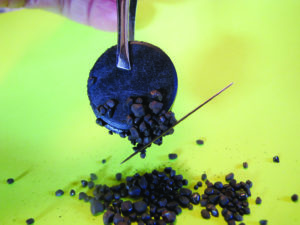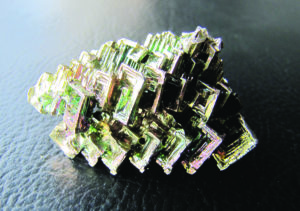God’s Magnetic Love
By Evelyn Sayler
After many years of rock collecting, I recently began branching out into a new area of exploring the wonders of God’s creation. I am becoming an arenophile—a sand collector. To the casual observer, sands may all look very much alike, but a good magnifying glass will often reveal surprisingly beautiful variations in color, shape, and texture. Sands reveal great variety, almost as much as rocks. With a little study, you, too, will be amazed.
 I found this variety to be true recently when I discovered a small patch of shiny black sand among the grey sand and stones by a rippling river. I gathered a small sample to add to my collection and thought little about it until winter came, and I had time to try to identify the mineral in the tiny specs. Neither my books nor the Internet was much help as most black sands appear very much the same.
I found this variety to be true recently when I discovered a small patch of shiny black sand among the grey sand and stones by a rippling river. I gathered a small sample to add to my collection and thought little about it until winter came, and I had time to try to identify the mineral in the tiny specs. Neither my books nor the Internet was much help as most black sands appear very much the same.
Then I tried using a magnet on the sand, and I quickly realized that it was magnetite, one of the most magnetic minerals. Even my weak little magnet instantly drew the sand together. The attraction made me think of the text, “‘And I, if I am lifted up from the earth, will draw all peoples to Myself’” (John 12:32). As He so often did, Jesus used the wonderful aspects of nature to illustrate spiritual truth.
In this case, I found the magnet to be a useful identification tool for my sand. Jesus is like a magnet that draws every sincere person to Him. Their response to His drawing is the way God identifies His true disciples.
Even though I had tried to pick up only the pure black sand, it was impossible not to get some grains of the common grey sand mixed in with it. Later I found an easy way to get rid of the grey sand. I used my magnet to pick up the black sand and transfer it to another container, leaving the unwanted grey sand behind. God also uses this method to separate the wheat from the tares on this earth. “‘The field is the world, the good seeds are the sons of the kingdom, but the tares are the sons of the wicked one’” (Matthew 13:38).
The wheat is attracted to Christ just as magnetite is attracted to a magnet. The common sand is left behind because of its own lack of response. Of course, sand has no choice in the matter, but we do. When we choose to respond to the upward drawing of God’s Spirit, the earthly impurities are left behind. This principle is also illustrated in the parable of the separating of the sheep and the goats in John 10:27, “‘My sheep hear My voice, and I know them, and they follow Me.’”
 I began testing to see if any of the many other minerals in my collection would respond to the pull of the magnet, but hematite (a closely related mineral) was the only one attracted to the magnetic pull. None of my pretty agates and other colorful stones showed any response at all to the power of the magnet. A very few minerals are diamagnetic, which means that they are repelled by a magnet. They move away from the magnet rather than being drawn toward it. Bismuth and graphite are two minerals that show this characteristic. Bismuth occasionally forms exquisite crystals that are unique, but, strangely, they are not diamagnetic.
I began testing to see if any of the many other minerals in my collection would respond to the pull of the magnet, but hematite (a closely related mineral) was the only one attracted to the magnetic pull. None of my pretty agates and other colorful stones showed any response at all to the power of the magnet. A very few minerals are diamagnetic, which means that they are repelled by a magnet. They move away from the magnet rather than being drawn toward it. Bismuth and graphite are two minerals that show this characteristic. Bismuth occasionally forms exquisite crystals that are unique, but, strangely, they are not diamagnetic.
We have all heard the Bible story about Jonah, who was repelled by God’s voice and tried to run away from it, with disastrous results. But the voice that spoke to Jonah was the same loving voice that calls each one of us to “‘Come to Me, all you who labor and are heavily laden, and I will give you rest’” (Matthew11:28). The problem with Jonah was not caused by the magnetic pull of God’s voice but by the wrong response to its drawing. Abraham was also called to do a very difficult task when God asked him to offer his son as a sacrifice, but because he responded with obedience, the challenge resulted in a great blessing.
 Another interesting thing happens when a mineral is drawn to a magnet. When the mineral gets attached to the magnet, the mineral itself becomes magnetized and draws other particles to itself. Then the next particle is able to draw another, and so on. In this way, a strong magnet can lift up a long chain of minerals, each one attached to the one above. The few grains of magnetite that were attached to my little magnet were able to lift up even a needle. But this magnetic power remains in the minerals only as long as they are attached to the magnet.
Another interesting thing happens when a mineral is drawn to a magnet. When the mineral gets attached to the magnet, the mineral itself becomes magnetized and draws other particles to itself. Then the next particle is able to draw another, and so on. In this way, a strong magnet can lift up a long chain of minerals, each one attached to the one above. The few grains of magnetite that were attached to my little magnet were able to lift up even a needle. But this magnetic power remains in the minerals only as long as they are attached to the magnet.
This is the way the magnet of God’s love works. In John 15:4 Jesus invites us to “‘Abide in Me, and I in you. As the branch cannot bear fruit of itself, unless it abides in the vine, neither can you, unless you abide in Me.’” The marginal reference for abiding in my favorite study Bible is “remain attached to.” We need not just a casual touch with Jesus. Only when we remain attached to Him can His drawing power flow through us to others and attract them to Him.
This powerful connection to Christ is what Scripture calls “partakers of the divine nature, having escaped the corruption that is in the world through lust” (2 Peter 1:4), and it leads to fruit-bearing or leading others to Jesus. Such purposeful discipleship provides the most fulfilling part of the Christian life. But, as with the power of the magnet, God’s drawing power remains in the believer only as long as we are firmly attached to Him, “‘for without Me you can do nothing’”(John 15:5).
__________________________________
Evelyn Sayler writes from Oliver, British Columbia, where she and her husband Floyd enjoy researching, experiencing, and sharing the wonders of God’s Creation.



